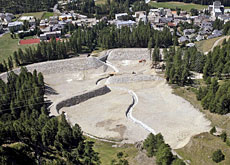Are the Alps becoming unstuck?

The permafrost – or "glue" – that holds the Alps together is dissolving due to rising temperatures, leaving scientists with more questions than answers.
They are scrambling to learn more about the permanently frozen layer found at high altitudes in order to respond to threats to mountain villages and infrastructure.
The tourist resort of Pontresina in southeastern Switzerland is protected by an embankment 13 metres high and 460 metres long. It cost SFr7 million ($5.77 million) to protect the mountain village from landslides that could destroy it completely.
That is because the permafrost above Pontresina has become susceptible to thawing under the impact of global warming. Tons of detritus could be released and carried down the slope by heavy rain.
This has happened several times across the Alps since the 1990s, but always below the zone of permafrost. This frozen layer of earth is widespread above an elevation of 2,500 metres but climate change is pushing it higher.
In the context of global warming, Swiss research is focussing not only on glaciers but also on permafrost, and investigations into this fragile frozen ground above Pontresina led to the warning that resulted in the construction of the embankment.
Permafrost covers 5 to 6 per cent of the Alps, or about twice as much area as do glaciers. The impact of global warming on the Alps has been one factor that has ensured continual monitoring since 2000.
Best open laboratory
Glaciologist Felix Keller of Academia Engiadina school calls the Upper Engadine valley where Pontresina is located the “best open laboratory in the world” where even the Japanese come to do research.
“I think the most interesting thing is that everything is so close at hand,” he told swissinfo.
“There are many natural processes that can be observed in a very small area such as debris flows, rock slides, glacier retreats, avalanches and mountain floods.”
Swiss permafrost specialists have carried out dozens of tests, drilling at depths up to 70 metres into the permafrost layer. Measurements have confirmed that the permafrost has heated up by one to two degrees in the last century.
This general warming tendency is however not clear cut. “The results are much less uniform than those for glaciers, which are all melting,” Reynald Delaloye of the University of Fribourg told swissinfo.
Rocky ridges
The scientists say the thawing of the permafrost layer is more significant on rocky ridges and steep slopes, for example, because the insulating influence of snow is minimal there.
The heatwave of the summer of 2003 caused several rock falls on the Matterhorn, Switzerland’s most famous peak, which led to the closure of paths to the mountain and the evacuation of dozens of climbers trapped on the summit.
On less steep ground, snow plays a central role. “Everything depends on its spatial and temporal distribution,” Marcia Phillips, one of three permafrost specialists at the snow and avalanche institute in Davos, explains.
Solid snow cover from the autumn allows the earth to conserve the heat absorbed during the summer and that’s bad for the permafrost. Snow in spring, on the other hand, will protect the earth from the first warm rays of the sun and rising temperatures.
Researchers are now more familiar with the diversity and the workings of permafrost but there is a lot more to learn.
Instability
Through continual observation, they are able to discover more about the natural dangers associated with permafrost, such as the instability of rocky ridges and movement of frozen ground. This information is helpful for modelling.
“If the warming takes place as forecast – up to five degrees in the Alps – we could experience new problems of instability in terms of magnitude and location, with effects down to low altitude,” Delaloye warns.
It is very difficult to estimate the economic, ecological and social impact of the disappearing permafrost, particularly as the thawing is linked to variations in precipitation.
But these effects are definitely real, mainly on high-altitude infrastructure such as mountain huts, and ski lift infrastructure which were sometimes built without taking the presence of permafrost and ice into account.
At Davos, researchers at the federal institute study the workings of avalanche dams on very steep frozen slopes. Based on this work, they published recommendations in 2000 on how to build this kind of structure in a permafrost zone.
“Avalanche barriers are intended to last 50 to 100 years,” Phillips points out. “But in unstable permafrost they might only last 20. Because they move and change shape and the anchors are ripped up or break.”
The Davos team is also working on recommendations for other constructions but only time will tell whether the findings will lead to solutions to stabilise slopes and protect villages.
swissinfo, based on a French article by Pierre-François Besson
Permafrost or permanently frozen ground is widespread in the Alps above 2500 m.
Permafrost terrain can be made up of ice-rich and potentially unstable sediments, such as scree, moraines and rock glaciers.
While permafrost in the alpine arc can penetrate the earth down to 100 metres, it has a depth of 1.5km in Eastern Siberia.
The authorities keep an up-to-date list of inhabited areas at risk of landslide.
Among these are the well-known holiday destinations of St Moritz, Zermatt and Kandersteg.

In compliance with the JTI standards
More: SWI swissinfo.ch certified by the Journalism Trust Initiative
You can find an overview of ongoing debates with our journalists here. Please join us!
If you want to start a conversation about a topic raised in this article or want to report factual errors, email us at english@swissinfo.ch.